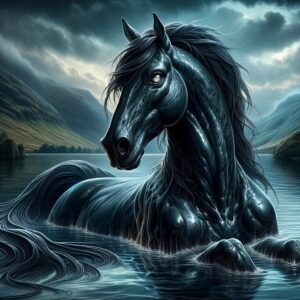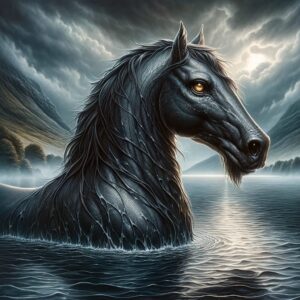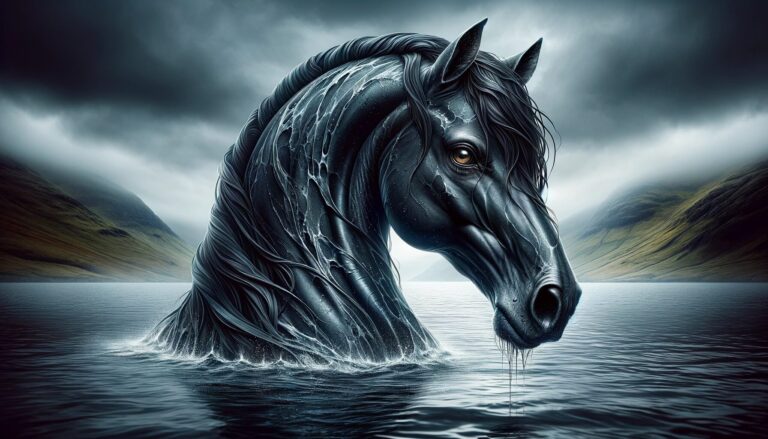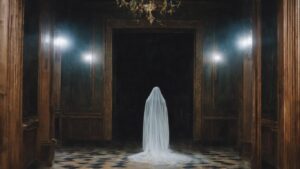Table of Contents
Kelpie – a Malevolent Waterhorse
In the eerie moors, shrouded by a river-born haze resembling hellish smoke, a weary traveler treaded a desolate path. To his astonishment, a pale, saddled horse materialized near the water’s edge, responding to his unspoken longing for swifter travel. Tentatively, he approached the ethereal equine, noting that its nicker held an inviting tone rather than fear. He seized the saddle horn, mounting the creature with disbelief and fortune intertwined. In an instant, the horse surged into a gallop, charging toward the river. Panic seized the man as he grappled with a supernatural grip that refused release. Oddly, the water did not impede the horse; instead, it conferred unnatural speed. A horrifying realization struck the man: this was no ordinary horse but a kelpie. His head plunged beneath the surface, vanishing forever from the world above.
Origin of the Kelpie
The kelpie is a creature steeped in Scottish folklore, firmly rooted in the mystical realm of faerie. Categorized as a water horse, the kelpie is far from benevolent; it is known for its malevolence. Often, it assumes the guise of a beautiful horse, typically found near or within running water. What sets it apart is its mane, which appears perpetually drenched. In some instances, female kelpies take on the form of beautiful women dressed in bewitching green attire, using their allure to ensnare and lure lustful men to their watery doom.
Historical Significance

Encountering a kelpie may seem avoidable, and indeed, it should be to a discerning traveler. Yet, these devious creatures have a knack for appearing alone, bridled, saddled, and ready to be ridden. Such a sight proves tantalizing to weary travelers, who often succumb to the seductive invitation. However, there are reasons beyond mere curiosity that drive individuals to seek out these perilous beasts.
Kelpies are said to possess formidable magical powers. Anyone who captures a kelpie can potentially harness these powers to their advantage. These supernatural steeds boast the strength of ten ordinary horses and endurance that far surpasses conventional limits. The key to capturing a kelpie lies in securing its bridle. Those who successfully employ a kelpie’s bridle can compel the creature to serve them. Whispers suggest that Clan MacGregor holds such a bridle, though whether a kelpie truly serves it remains a mystery, known solely to the MacGregors. Nevertheless, many consider capturing and retaining a kelpie or any other faerie realm inhabitant a perilous venture.
Mere contact with these creatures sets in motion one of their magical abilities—the power to adhere human flesh to their own. A harrowing tale recounts a child who, enticed to stroke a kelpie’s nose, managed to escape but was forced to sever his own finger to break free.
But adhering flesh is only one facet of a kelpie’s arsenal. These enigmatic beings wield a tail capable of striking the water with such force that it produces a deafening clap of thunder. The resulting deluge can drag an unsuspecting human into the water’s depths, where the kelpie will inexorably pull them to their demise.
Current Influence of the Kelpie
The kelpie, serving as a water horse, has etched an indelible mark upon the tapestry of Scottish legend and folklore. In fact, scholars have frequently proposed that the enigmatic Loch Ness Monster might represent a manifestation of the kelpie. Virtually every river, stream, or lake in Scotland possesses its individual kelpie legend, and this treacherous creature haunts the collective memory of the Scottish people, establishing itself as a formidable presence that the unwary traveler cannot easily evade.
Appearance and Characteristics

Ethereal Beauty: At first glance, the Kelpie appears as a stunning horse, exuding an otherworldly charm. Its coat glistens with an unearthly glow, captivating the beholder with an almost hypnotic allure. Its physical form seems almost too perfect to be real, luring unsuspecting individuals into its clutches.
Drenched Mane: One of the most distinctive features of the Kelpie is its mane, which perpetually appears to be dripping wet. This constant flow of water from its mane adds to the illusion that it has just emerged from the depths of the water it calls home. The wetness of its mane serves as a haunting reminder of its aquatic origins.
Feminine Allure: While the Kelpie predominantly assumes the guise of a magnificent horse, it also possesses the ability to take on a more bewitching form. Female Kelpies may appear as beautiful women, often dressed in enchanting green attire. This seductive incarnation serves as a means to ensnare and lead lustful men to their watery doom.
Deceptive Exterior: The Kelpie’s alluring exterior belies the malevolence that dwells within. Its captivating appearance serves as a cunning disguise, drawing in unsuspecting victims who mistake it for an ordinary horse.
Mystical Nature: As a creature deeply intertwined with the faerie realm, the Kelpie possesses a mystique that extends beyond its physical appearance. It is a being shrouded in mystery, capable of both enchanting and ensnaring those who cross its path.
Supernatural Abilities: Beyond its captivating appearance, the Kelpie wields a formidable array of supernatural abilities. These include the power to adhere human flesh to its own, a feat that renders escape a harrowing ordeal. It can also unleash a thunderous flood by striking the water’s surface with its tail, a deadly tactic used to drag unsuspecting victims into the depths.
Origins and Folklore
The kelpie finds its origins deeply entrenched in the mystical realms of Scottish folklore. It is a creature of the faerie realm, often associated with the most treacherous aspects of nature—water. While the kelpie predominantly assumes the form of a horse, its malevolent nature sets it apart from any ordinary equine. Legends abound, recounting encounters with these sinister beings near rivers, lochs, and streams.
The Deceptive Invitation
To encounter a kelpie is to confront temptation veiled in the cloak of despair. When spotted, these creatures are rarely alone; they stand bridled and saddled, poised for a rider. To the weary traveler, this sight appears as an alluring invitation, a respite from the endless road. Yet, it is in the very act of mounting a kelpie that the unwitting victim seals their grim fate.
The Temptation of Power
The allure of capturing a kelpie lies not only in escaping its clutches but in harnessing its potent magic. Possessing the strength of ten horses and the stamina to traverse unfathomable distances, a kelpie is a creature of extraordinary power. However, to secure its allegiance, one must master the art of the kelpie bridle—a perilous endeavor in itself.
Malevolent Magic
A kelpie wields a unique form of magic, one that can spell doom for the unwary. A simple touch activates this magic, binding human flesh to its own, rendering escape a perilous and painful endeavor. Tales recount the desperate measures taken by those who have come into contact with a kelpie, including self-mutilation to break free.
The Thunderous Tail
The kelpie’s supernatural abilities extend to the very elements it calls home. With a powerful strike of its tail upon the water’s surface, a kelpie can unleash a deafening clap of thunder. This mystical act summons a devastating flood that engulfs any unfortunate soul in its path, dragging them inexorably into the watery abyss.
Enduring Legacy
The kelpie, as a water horse, has etched its indelible presence across the landscape of Scottish legend. The lore of this enigmatic creature has intertwined with the very fabric of Scotland’s rivers, lochs, and streams. From Loch Ness to the smallest brook, the kelpie’s influence endures, serving as a haunting reminder of the perilous waters that conceal its sinister secrets.
In conclusion, the kelpie is a creature of unparalleled beauty and malevolence, deeply entwined in the mystique of Scottish folklore. Its beguiling appearance masks a treacherous nature, and its supernatural abilities have both fascinated and terrified generations. As it continues to lurk in the waters of Scotland, the kelpie remains an enduring enigma, a testament to the enduring power of myth and legend.
Similarities
Each Uisge (Each Uisge, Aughisky): This creature, known in different forms in Irish and Scottish folklore, is often referred to as the “water horse” or “water kelpie.” Similar to the Kelpie, it lures unsuspecting travelers into the water to drown them.
Nuckelavee (Orkney Islands): The Nuckelavee is a grotesque water creature that terrorizes the Orkney Islands. It is often depicted as a horse-like creature with a rider fused to its back. Like the Kelpie, it is malevolent and seeks to harm humans.
Bäckahäst (Sweden): The Bäckahäst, or “brook horse,” is a water spirit that takes the form of a beautiful horse. It lures people, especially children, to ride on its back before diving into the water, where it drags them to their doom.
Näkki (Finland): The Näkki is a malevolent water spirit in Finnish folklore. It often appears as a horse-like creature or a beautiful woman near water bodies, luring unsuspecting individuals to their demise in the water.
Kawa-no-kami (Japan): In Japanese folklore, the Kawa-no-kami, or “river deity,” is a spirit associated with rivers and water bodies. It can take the form of a horse and is known to cause floods and drownings.
Bunyip (Australia): While not directly similar in appearance, the Bunyip is a mythical water creature from Australian Aboriginal folklore. It is said to inhabit swamps, rivers, and billabongs and is often associated with water-related dangers.
FAQ
Where are Kelpies found in folklore?
Predominantly in Scottish and Celtic folklore.
Do Kelpies always appear as horses?
They can also take on the form of a beautiful woman.
How do Kelpies lure victims?
They entice people to ride them, then drag them underwater.
Are Kelpies considered malevolent?
Yes, they are known for their harmful intent.
What happens when someone touches a Kelpie?
The victim is ensnared by the Kelpie's magic.
Is there a way to control or capture a Kelpie?
A special bridle is needed; Clan MacGregor is rumored to possess one.
Are there similar creatures in other cultures?
Yes, various water spirits share similarities worldwide.
Are Kelpies still part of modern folklore?
They persist in Scottish and Celtic folklore and inspire art and literature.
Is there a connection between Kelpies and Loch Ness Monster myths?
Speculation exists, given their shared association with Scottish waters.





